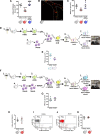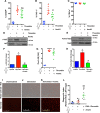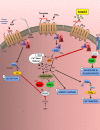Novel Role for the AnxA1-Fpr2/ALX Signaling Axis as a Key Regulator of Platelet Function to Promote Resolution of Inflammation
- PMID: 31154815
- PMCID: PMC6687438
- DOI: 10.1161/CIRCULATIONAHA.118.039345
Novel Role for the AnxA1-Fpr2/ALX Signaling Axis as a Key Regulator of Platelet Function to Promote Resolution of Inflammation
Erratum in
-
Correction to: Novel Role for the AnxA1-Fpr2/ALX Signaling Axis as a Key Regulator of Platelet Function to Promote Resolution of Inflammation.Circulation. 2019 Jul 23;140(4):e172. doi: 10.1161/CIR.0000000000000713. Epub 2019 Jul 22. Circulation. 2019. PMID: 31329483 Free PMC article. No abstract available.
Abstract
Background: Ischemia reperfusion injury (I/RI) is a common complication of cardiovascular diseases. Resolution of detrimental I/RI-generated prothrombotic and proinflammatory responses is essential to restore homeostasis. Platelets play a crucial part in the integration of thrombosis and inflammation. Their role as participants in the resolution of thromboinflammation is underappreciated; therefore we used pharmacological and genetic approaches, coupled with murine and clinical samples, to uncover key concepts underlying this role.
Methods: Middle cerebral artery occlusion with reperfusion was performed in wild-type or annexin A1 (AnxA1) knockout (AnxA1-/-) mice. Fluorescence intravital microscopy was used to visualize cellular trafficking and to monitor light/dye-induced thrombosis. The mice were treated with vehicle, AnxA1 (3.3 mg/kg), WRW4 (1.8 mg/kg), or all 3, and the effect of AnxA1 was determined in vivo and in vitro.
Results: Intravital microscopy revealed heightened platelet adherence and aggregate formation post I/RI, which were further exacerbated in AnxA1-/- mice. AnxA1 administration regulated platelet function directly (eg, via reducing thromboxane B2 and modulating phosphatidylserine expression) to promote cerebral protection post-I/RI and act as an effective preventative strategy for stroke by reducing platelet activation, aggregate formation, and cerebral thrombosis, a prerequisite for ischemic stroke. To translate these findings into a clinical setting, we show that AnxA1 plasma levels are reduced in human and murine stroke and that AnxA1 is able to act on human platelets, suppressing classic thrombin-induced inside-out signaling events (eg, Akt activation, intracellular calcium release, and Ras-associated protein 1 [Rap1] expression) to decrease αIIbβ3 activation without altering its surface expression. AnxA1 also selectively modifies cell surface determinants (eg, phosphatidylserine) to promote platelet phagocytosis by neutrophils, thereby driving active resolution. (n=5-13 mice/group or 7-10 humans/group.) Conclusions: AnxA1 affords protection by altering the platelet phenotype in cerebral I/RI from propathogenic to regulatory and reducing the propensity for platelets to aggregate and cause thrombosis by affecting integrin (αIIbβ3) activation, a previously unknown phenomenon. Thus, our data reveal a novel multifaceted role for AnxA1 to act both as a therapeutic and a prophylactic drug via its ability to promote endogenous proresolving, antithromboinflammatory circuits in cerebral I/RI. Collectively, these results further advance our knowledge and understanding in the field of platelet and resolution biology.
Keywords: annexin A1; formyl peptide receptor; inflammation; integrins; stroke; thrombosis.
Figures








Similar articles
-
Targeting AnxA1/Formyl Peptide Receptor 2 Pathway Affords Protection against Pathological Thrombo-Inflammation.Cells. 2020 Nov 13;9(11):2473. doi: 10.3390/cells9112473. Cells. 2020. PMID: 33202930 Free PMC article.
-
Annexin A1 protects against cerebral ischemia-reperfusion injury by modulating microglia/macrophage polarization via FPR2/ALX-dependent AMPK-mTOR pathway.J Neuroinflammation. 2021 May 22;18(1):119. doi: 10.1186/s12974-021-02174-3. J Neuroinflammation. 2021. PMID: 34022892 Free PMC article.
-
Deletion of Annexin A1 in Mice Upregulates the Expression of Its Receptor, Fpr2/3, and Reactivity to the AnxA1 Mimetic Peptide in Platelets.Int J Mol Sci. 2023 Feb 8;24(4):3424. doi: 10.3390/ijms24043424. Int J Mol Sci. 2023. PMID: 36834844 Free PMC article.
-
Annexin A1 and the Resolution of Inflammation: Modulation of Neutrophil Recruitment, Apoptosis, and Clearance.J Immunol Res. 2016;2016:8239258. doi: 10.1155/2016/8239258. Epub 2016 Jan 13. J Immunol Res. 2016. PMID: 26885535 Free PMC article. Review.
-
The advantageous role of annexin A1 in cardiovascular disease.Cell Adh Migr. 2017 May 4;11(3):261-274. doi: 10.1080/19336918.2016.1259059. Epub 2016 Nov 18. Cell Adh Migr. 2017. PMID: 27860536 Free PMC article. Review.
Cited by
-
Thromboinflammatory mechanisms in sickle cell disease - challenging the hemostatic balance.Haematologica. 2020 Oct 1;105(10):2380-2390. doi: 10.3324/haematol.2019.239343. Haematologica. 2020. PMID: 33054078 Free PMC article.
-
SPP1/AnxA1/TIMP1 as Essential Genes Regulate the Inflammatory Response in the Acute Phase of Cerebral Ischemia-Reperfusion in Rats.J Inflamm Res. 2022 Aug 24;15:4873-4890. doi: 10.2147/JIR.S369690. eCollection 2022. J Inflamm Res. 2022. PMID: 36046663 Free PMC article.
-
Targeting AnxA1/Formyl Peptide Receptor 2 Pathway Affords Protection against Pathological Thrombo-Inflammation.Cells. 2020 Nov 13;9(11):2473. doi: 10.3390/cells9112473. Cells. 2020. PMID: 33202930 Free PMC article.
-
ANXA1-FPR2 axis mitigates the susceptibility to atrial fibrillation in obesity via rescuing AMPK activity in response to lipid overload.Cardiovasc Diabetol. 2024 Dec 21;23(1):452. doi: 10.1186/s12933-024-02545-z. Cardiovasc Diabetol. 2024. PMID: 39709478 Free PMC article.
-
Annexin A1: The dawn of ischemic stroke (Review).Mol Med Rep. 2025 Mar;31(3):62. doi: 10.3892/mmr.2024.13427. Epub 2025 Jan 3. Mol Med Rep. 2025. PMID: 39749707 Free PMC article. Review.
References
-
- Esmon CT. Crosstalk between inflammation and thrombosis. Maturitas. 2008;61:122–131. doi: 10.1016/j.maturitas.2003.10.015. - PubMed
Publication types
MeSH terms
Substances
Grants and funding
LinkOut - more resources
Full Text Sources
Other Literature Sources
Molecular Biology Databases
Research Materials
Miscellaneous

